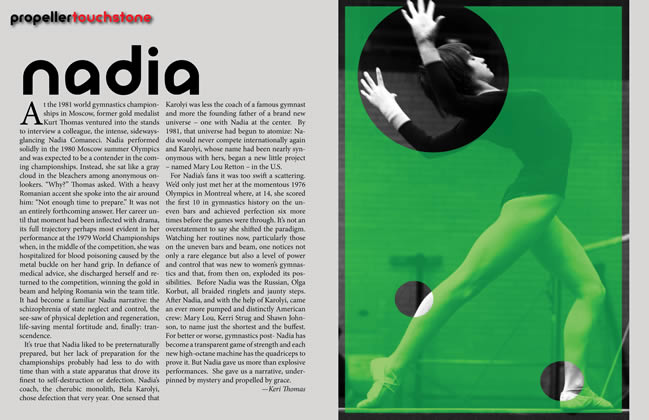
At the 1981 world gymnastics championships in Moscow, former gold medalist Kurt Thomas ventured into the stands to interview a colleague, the intense, sideways-glancing Nadia Comaneci. Nadia performed solidly in the 1980 Moscow summer Olympics and was expected to be a contender in the coming championships. Instead, she sat like a gray cloud in the bleachers among anonymous onlookers. "Why?" Thomas asked. With a heavy Romanian accent she spoke into the air around him: "Not enough time to prepare." It was not an entirely forthcoming answer. Her career until that moment had been inflected with drama, its full trajectory perhaps most evident in her performance at the 1979 World Championships when, in the middle of the competition, she was hospitalized for blood poisoning caused by the metal buckle on her hand grip. In defiance of medical advice, she discharged herself and returned to the competition, winning the gold in beam and helping Romania win the team title. It had become a familiar Nadia narrative: the schizophrenia of state neglect and control, the see-saw of physical depletion and regeneration, life-saving mental fortitude and, finally: transcendence.
It's true that Nadia liked to be preternaturally prepared, but her lack of preparation for the championships probably had less to do with time than with a state apparatus that drove its finest to self-destruction or defection. Nadia's coach, the cherubic monolith, Bela Karolyi, chose defection that very year. One sensed that Karolyi was less the coach of a famous gymnast and more the founding father of a brand new universe – one with Nadia at the center. By 1981, that universe had begun to atomize: Nadia would never compete internationally again and Karolyi, whose name had been nearly synonymous with hers, began a new little project – named Mary Lou Retton – in the U.S.
For Nadia's fans it was too swift a scattering. We'd only just met her at the momentous 1976 Olympics in Montreal where, at 14, she scored the first 10 in gymnastics history on the uneven bars and achieved perfection six more times before the games were through. It's not an overstatement to say she shifted the paradigm. Watching her routines now, particularly those on the uneven bars and beam, one notices not only a rare elegance but also a level of power and control that was new to women's gymnastics and that, from then on, exploded its possibilities. Before Nadia was the Russian, Olga Korbut, all braided ringlets and jaunty steps. After Nadia, and with the help of Karolyi, came an ever more pumped and distinctly American crew: Mary Lou, Kerri Strug and Shawn Johnson, to name just the shortest and the buffest. For better or worse, gymnastics post- Nadia has become a transparent game of strength and each new high-octane machine has the quadriceps to prove it. But Nadia gave us more than explosive performances. She gave us a narrative, underpinned by mystery and propelled by grace. —Keri Thomas
Keri Thomas is a writer and filmmaker. In the October 2009 issue, she wrote about the emotional lives of animals.


